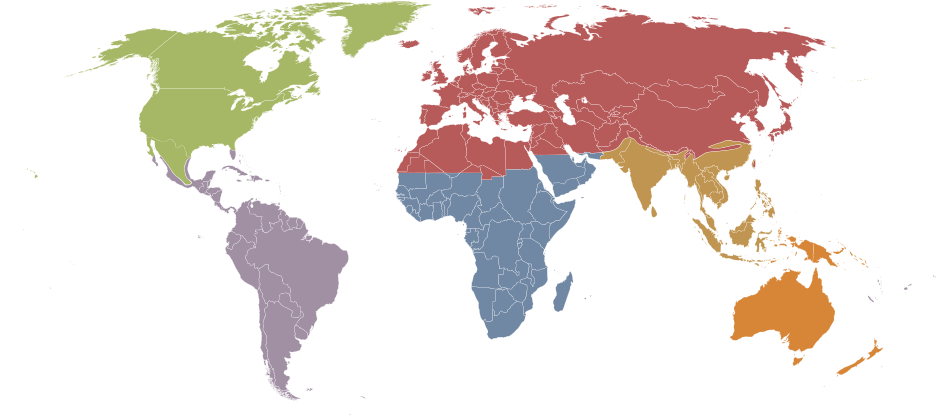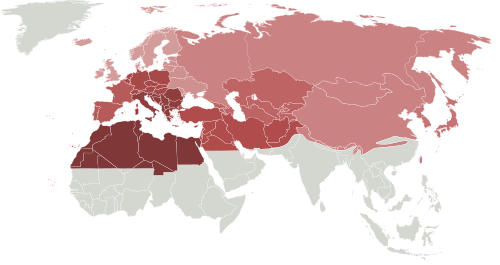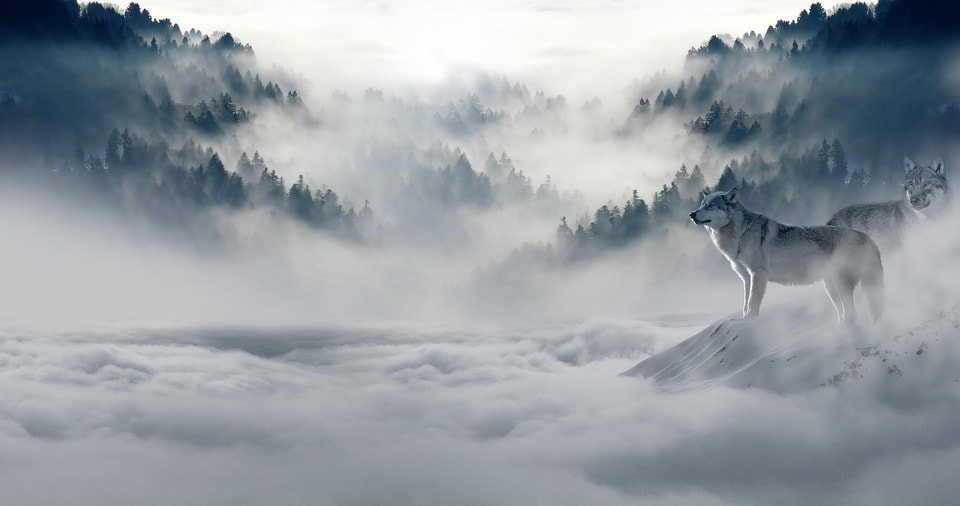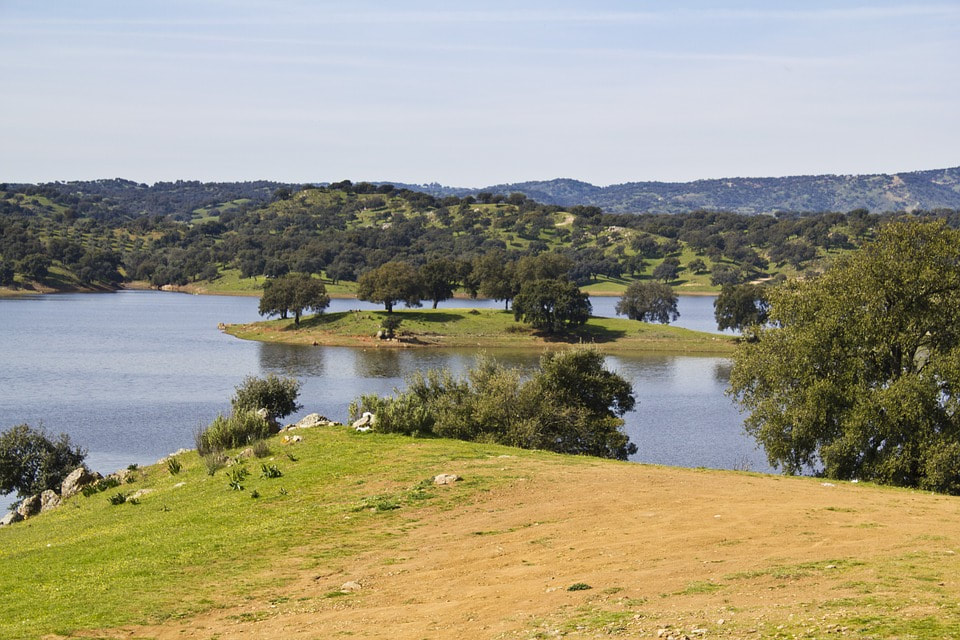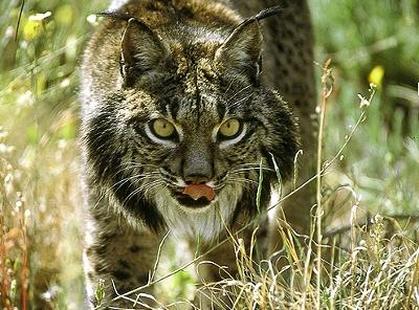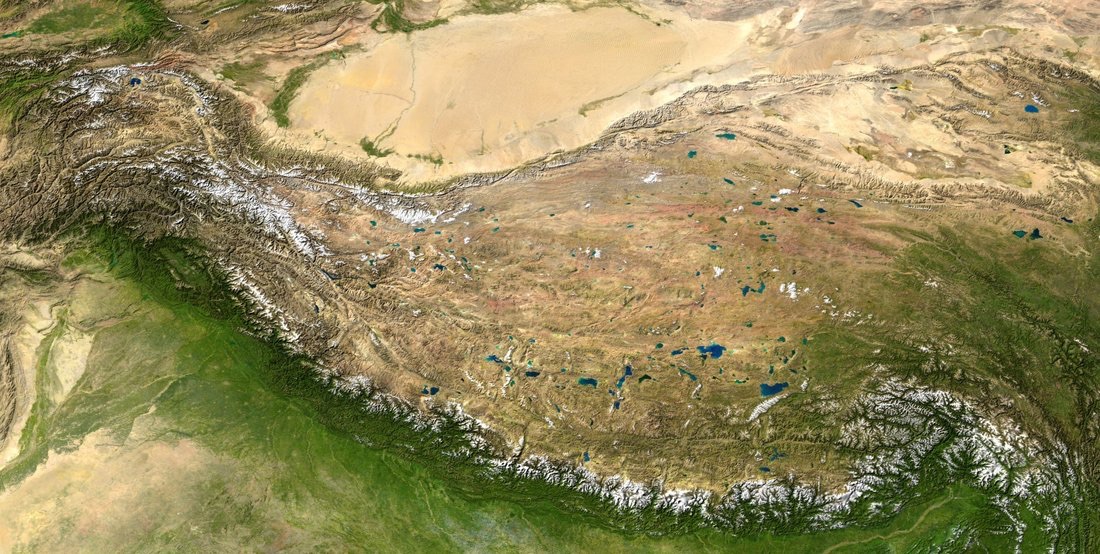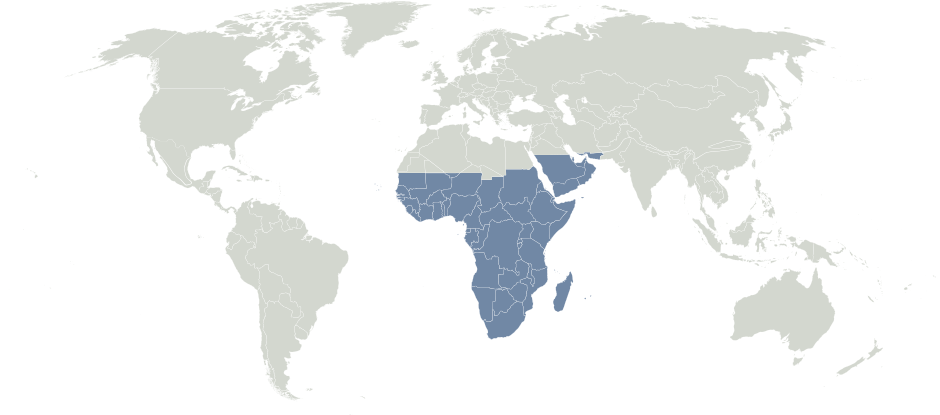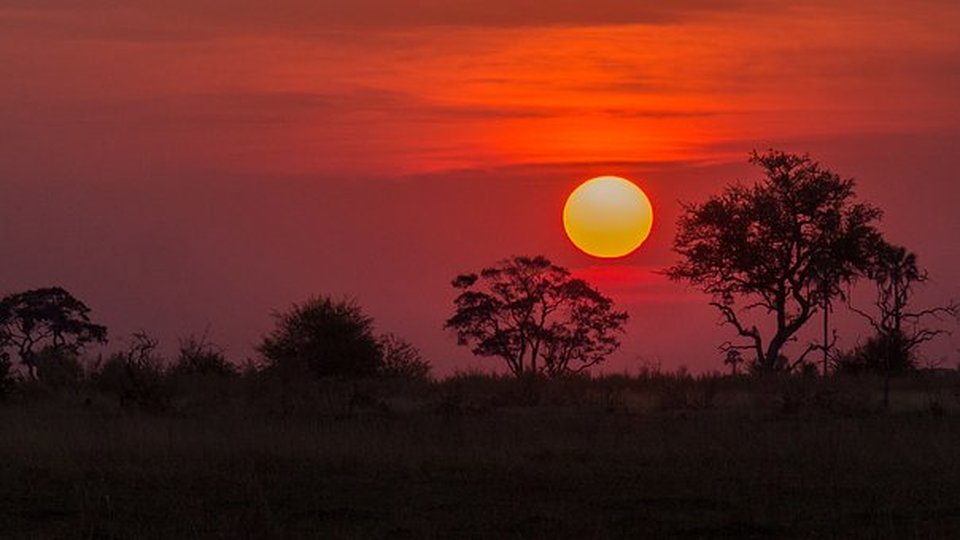Palearctic
The Palearctic or Palaearctic is one of the eight biogeographic realms on the Earth's surface. It is the largest of the eight realms. It stretches across all of Europe, Asia north of the foothills of the Himalayas, North Africa, and the northern and central parts of the Arabian Peninsula.
The realm consists of several ecoregions: the Euro-Siberian region; the Mediterranean Basin; the Sahara and Arabian Deserts; and Western, Central and East Asia. The Palaearctic realm also has numerous rivers and lakes, forming several freshwater ecoregions. Some of the rivers were the source of water for the earliest recorded civilizations that used irrigation methods.
The Palearctic realm includes mostly boreal/subarctic-climate and temperate-climate ecoregions, which run across Eurasia from western Europe to the Bering Sea.
The realm consists of several ecoregions: the Euro-Siberian region; the Mediterranean Basin; the Sahara and Arabian Deserts; and Western, Central and East Asia. The Palaearctic realm also has numerous rivers and lakes, forming several freshwater ecoregions. Some of the rivers were the source of water for the earliest recorded civilizations that used irrigation methods.
The Palearctic realm includes mostly boreal/subarctic-climate and temperate-climate ecoregions, which run across Eurasia from western Europe to the Bering Sea.
Euro-Siberian region
The boreal and temperate Euro-Siberian region is the Palearctic's largest biogeographic region, which transitions from tundra in the northern reaches of Russia and Scandinavia to the vast taiga, the boreal coniferous forests which run across the continent. South of the taiga are a belt of temperate broadleaf and mixed forests and temperate coniferous forests. This vast Euro-Siberian region is characterized by many shared plant and animal species, and has many affinities with the temperate and boreal regions of the Nearctic ecoregion of North America. Eurasia and North America were often connected by the Bering land bridge, and have very similar mammal and bird fauna, with many Eurasian species having moved into North America, and fewer North American species having moved into Eurasia. Many zoologists consider the Palearctic and Nearctic to be a single Holarctic realm.
The boreal and temperate Euro-Siberian region is the Palearctic's largest biogeographic region, which transitions from tundra in the northern reaches of Russia and Scandinavia to the vast taiga, the boreal coniferous forests which run across the continent. South of the taiga are a belt of temperate broadleaf and mixed forests and temperate coniferous forests. This vast Euro-Siberian region is characterized by many shared plant and animal species, and has many affinities with the temperate and boreal regions of the Nearctic ecoregion of North America. Eurasia and North America were often connected by the Bering land bridge, and have very similar mammal and bird fauna, with many Eurasian species having moved into North America, and fewer North American species having moved into Eurasia. Many zoologists consider the Palearctic and Nearctic to be a single Holarctic realm.
Mediterranean Basin
The lands bordering the Mediterranean Sea in southern Europe, north Africa, and western Asia are home to the Mediterranean Basin ecoregions, which together constitute the world's largest and most diverse mediterranean climate region of the world, with generally mild, rainy winters and hot, dry summers. The Mediterranean basin's mosaic of Mediterranean forests, woodlands, and scrub are home to 13,000 endemic species. Formerly the region was mostly covered with forests and woodlands, but heavy human use has reduced much of the region to the sclerophyll shrublands known as chaparral, matorral, maquis, or garrigue.
The lands bordering the Mediterranean Sea in southern Europe, north Africa, and western Asia are home to the Mediterranean Basin ecoregions, which together constitute the world's largest and most diverse mediterranean climate region of the world, with generally mild, rainy winters and hot, dry summers. The Mediterranean basin's mosaic of Mediterranean forests, woodlands, and scrub are home to 13,000 endemic species. Formerly the region was mostly covered with forests and woodlands, but heavy human use has reduced much of the region to the sclerophyll shrublands known as chaparral, matorral, maquis, or garrigue.
Sahara and Arabian deserts
A great belt of deserts, including the Atlantic coastal desert, Sahara desert, and Arabian desert, separates the Palearctic and Afrotropic ecoregions. This scheme includes these desert ecoregions in the palearctic realm; other biogeographers identify the realm boundary as the transition zone between the desert ecoregions and the Mediterranean basin ecoregions to the north, which places the deserts in the Afrotropic, while others place the boundary through the middle of the desert.
A great belt of deserts, including the Atlantic coastal desert, Sahara desert, and Arabian desert, separates the Palearctic and Afrotropic ecoregions. This scheme includes these desert ecoregions in the palearctic realm; other biogeographers identify the realm boundary as the transition zone between the desert ecoregions and the Mediterranean basin ecoregions to the north, which places the deserts in the Afrotropic, while others place the boundary through the middle of the desert.
Western and Central Asia
The Caucasus mountains, which run between the Black Sea and the Caspian Sea, are a particularly rich mix of coniferous, broadleaf, and mixed forests, and include the temperate rain forests of the Euxine-Colchic deciduous forests ecoregion.
Central Asia and the Iranian plateau are home to dry steppe grasslands and desert basins, with montane forests, woodlands, and grasslands in the region's high mountains and plateaux. In southern Asia the boundary of the Palearctic is largely altitudinal. The middle altitude foothills of the Himalaya between about 2000–2500 m form the boundary between the Palearctic and Indomalaya ecoregions.
East Asia
China, Korea and Japan are more humid and temperate than adjacent Siberia and Central Asia, and are home to rich temperate coniferous, broadleaf, and mixed forests, which are now mostly limited to mountainous areas, as the densely populated lowlands and river basins have been converted to intensive agricultural and urban use. In the subtropical region of southern China and southern edge of the Himalayas, the Palearctic temperate forests transition to the subtropical and tropical forests of Indomalaya, creating a rich and diverse mix of plant and animal species. The mountains of southwest China are also designated as a biodiversity hotspot. In Southeastern Asia, high mountain ranges form tongues of Palearctic flora and fauna in northern Indochina and southern China. Isolated small outposts (sky islands) occur as far south as central Myanmar, northernmost Vietnam and the high mountains of Taiwan.
The Caucasus mountains, which run between the Black Sea and the Caspian Sea, are a particularly rich mix of coniferous, broadleaf, and mixed forests, and include the temperate rain forests of the Euxine-Colchic deciduous forests ecoregion.
Central Asia and the Iranian plateau are home to dry steppe grasslands and desert basins, with montane forests, woodlands, and grasslands in the region's high mountains and plateaux. In southern Asia the boundary of the Palearctic is largely altitudinal. The middle altitude foothills of the Himalaya between about 2000–2500 m form the boundary between the Palearctic and Indomalaya ecoregions.
East Asia
China, Korea and Japan are more humid and temperate than adjacent Siberia and Central Asia, and are home to rich temperate coniferous, broadleaf, and mixed forests, which are now mostly limited to mountainous areas, as the densely populated lowlands and river basins have been converted to intensive agricultural and urban use. In the subtropical region of southern China and southern edge of the Himalayas, the Palearctic temperate forests transition to the subtropical and tropical forests of Indomalaya, creating a rich and diverse mix of plant and animal species. The mountains of southwest China are also designated as a biodiversity hotspot. In Southeastern Asia, high mountain ranges form tongues of Palearctic flora and fauna in northern Indochina and southern China. Isolated small outposts (sky islands) occur as far south as central Myanmar, northernmost Vietnam and the high mountains of Taiwan.
|
source: Wikipedia
|
TIBETAN PLATEAU url
|
source: cuora.com
Freshwater
The realm contains several important freshwater ecoregions as well, including the heavily developed rivers of Europe, the rivers of Russia, which flow into the Arctic, Baltic, Black, and Caspian seas, Siberia's Lake Baikal, the oldest and deepest lake on the planet, and Japan's ancient Lake Biwa.
The realm contains several important freshwater ecoregions as well, including the heavily developed rivers of Europe, the rivers of Russia, which flow into the Arctic, Baltic, Black, and Caspian seas, Siberia's Lake Baikal, the oldest and deepest lake on the planet, and Japan's ancient Lake Biwa.
FLORA AND FAUNA
One bird family, the accentors (Prunellidae) is endemic to the Palearctic region. The Holarctic has four other endemic bird families: the divers or loons (Gaviidae), grouse (Tetraoninae), auks (Alcidae), and waxwings (Bombycillidae).
There are no endemic mammal orders in the region, but several families are endemic: Calomyscidae (mouse-like hamsters), Prolagidae, and Ailuridae (red pandas). Several mammal species originated in the Palearctic, and spread to the Nearctic during the Ice Age, including the brown bear (Ursus arctos, known in North America as the grizzly), red deer (Cervus elaphus) in Europe and the closely related elk (Cervus canadensis) in far eastern Siberia, American bison (Bison bison), and reindeer (Rangifer tarandus, known in North America as the caribou).
Several large Palearctic animals became extinct from the end of the Pleistocene into historic times, including the Irish elk (Megaloceros giganteus), aurochs (Bos primigenius) woolly rhinoceros(Coelodonta antiquitatis), woolly mammoth (Mammuthus primigenius), North African elephant (Loxodonta africana pharaoensis), Chinese elephant (Elephas maximus rubridens), cave bear (Ursus spelaeus), and European lion (Panthera leo europaea).
(Source: en.wikipedia.org)
One bird family, the accentors (Prunellidae) is endemic to the Palearctic region. The Holarctic has four other endemic bird families: the divers or loons (Gaviidae), grouse (Tetraoninae), auks (Alcidae), and waxwings (Bombycillidae).
There are no endemic mammal orders in the region, but several families are endemic: Calomyscidae (mouse-like hamsters), Prolagidae, and Ailuridae (red pandas). Several mammal species originated in the Palearctic, and spread to the Nearctic during the Ice Age, including the brown bear (Ursus arctos, known in North America as the grizzly), red deer (Cervus elaphus) in Europe and the closely related elk (Cervus canadensis) in far eastern Siberia, American bison (Bison bison), and reindeer (Rangifer tarandus, known in North America as the caribou).
Several large Palearctic animals became extinct from the end of the Pleistocene into historic times, including the Irish elk (Megaloceros giganteus), aurochs (Bos primigenius) woolly rhinoceros(Coelodonta antiquitatis), woolly mammoth (Mammuthus primigenius), North African elephant (Loxodonta africana pharaoensis), Chinese elephant (Elephas maximus rubridens), cave bear (Ursus spelaeus), and European lion (Panthera leo europaea).
(Source: en.wikipedia.org)
Afrotropic
The Afrotropical realm is one of the Earth's eight biogeographic realms. It includes Africa south of the Sahara Desert, the southern and eastern fringes of the Arabian Peninsula, the island of Madagascar, southern Iran and extreme southwestern Pakistan, and the islands of the western Indian Ocean. It was formerly known as the Ethiopian Zone or Ethiopian Region.
Major ecological regions
Most of the Afrotropic, with the exception of Africa's southern tip, has a tropical climate. A broad belt of deserts, including the Atlantic and Sahara deserts of northern Africa and the Arabian Desert of the Arabian Peninsula, separate the Afrotropic from the Palearctic realm, which includes northern Africa and temperate Eurasia.
Sahel and Sudan
South of the Sahara, two belts of tropical grassland and savanna run east and west across the continent, from the Atlantic Ocean to the Ethiopian Highlands. Immediately south of the Sahara lies the Sahel belt, a transitional zone of semi-arid short grassland and acacia savanna. Rainfall increases further south in the Sudanian Savanna, also known simply as the Sudan, a belt of taller grasslands and savannas. The Sudanian Savanna is home to two great flooded grasslands, the Sudd wetland in South Sudan, and the Niger Inland Delta in Mali. The forest-savanna mosaic is a transitional zone between the grasslands and the belt of tropical moist broadleaf forests near the equator.
Southern Arabian woodlands
South Arabia, expressed as being mostly Yemen and parts of western Oman and southwestern Saudi Arabia, has few permanent forests. Some of the notable are Jabal Bura', Jabal Raymah, and Jabal Badaj in the Yemeni highland escarpment, and the seasonal forests in eastern Yemen and the Dhofar region of Oman. Other woodlands scatter the land and are very small and are predominantly juniperor acacia forests.
Forest zone
The forest zone, a belt of lowland tropical moist broadleaf forests, runs across most of equatorial Africa's intertropical convergence zone. The Upper Guinean forests of West Africa extend along the coast from Guinea to Togo. The Dahomey Gap, a zone of forest-savanna mosaic that reaches to the coast, separates the Upper Guinean forests from the Lower Guinean forests, which extend along the Gulf of Guinea from eastern Benin through Cameroon and Gabon to the western Democratic Republic of the Congo. The largest tropical forest zone in Africa is the Congolian forests of the Congo Basin in Central Africa. A belt of tropical moist broadleaf forest also runs along the Indian Ocean coast, from southern Somalia to South Africa.
East African grasslands and savannas
Most of the Afrotropic, with the exception of Africa's southern tip, has a tropical climate. A broad belt of deserts, including the Atlantic and Sahara deserts of northern Africa and the Arabian Desert of the Arabian Peninsula, separate the Afrotropic from the Palearctic realm, which includes northern Africa and temperate Eurasia.
Sahel and Sudan
South of the Sahara, two belts of tropical grassland and savanna run east and west across the continent, from the Atlantic Ocean to the Ethiopian Highlands. Immediately south of the Sahara lies the Sahel belt, a transitional zone of semi-arid short grassland and acacia savanna. Rainfall increases further south in the Sudanian Savanna, also known simply as the Sudan, a belt of taller grasslands and savannas. The Sudanian Savanna is home to two great flooded grasslands, the Sudd wetland in South Sudan, and the Niger Inland Delta in Mali. The forest-savanna mosaic is a transitional zone between the grasslands and the belt of tropical moist broadleaf forests near the equator.
Southern Arabian woodlands
South Arabia, expressed as being mostly Yemen and parts of western Oman and southwestern Saudi Arabia, has few permanent forests. Some of the notable are Jabal Bura', Jabal Raymah, and Jabal Badaj in the Yemeni highland escarpment, and the seasonal forests in eastern Yemen and the Dhofar region of Oman. Other woodlands scatter the land and are very small and are predominantly juniperor acacia forests.
Forest zone
The forest zone, a belt of lowland tropical moist broadleaf forests, runs across most of equatorial Africa's intertropical convergence zone. The Upper Guinean forests of West Africa extend along the coast from Guinea to Togo. The Dahomey Gap, a zone of forest-savanna mosaic that reaches to the coast, separates the Upper Guinean forests from the Lower Guinean forests, which extend along the Gulf of Guinea from eastern Benin through Cameroon and Gabon to the western Democratic Republic of the Congo. The largest tropical forest zone in Africa is the Congolian forests of the Congo Basin in Central Africa. A belt of tropical moist broadleaf forest also runs along the Indian Ocean coast, from southern Somalia to South Africa.
East African grasslands and savannas
- Acacia-Commiphora grasslands
- Serengeti
|
Eastern Africa's highlands
Afromontane region, from the Ethiopian Highlands to the Drakensberg Mountains of South Africa, including the East African Rift. Distinctive flora, including Podocarpus and Afrocarpus, as well as giant Lobelias and Senecios. |
Southern African woodlands, savannas, and grasslands
Cape floristic region
The Cape floristic region, at Africa's southern tip, is a Mediterranean climate region that is home to a significant number of endemic taxa, as well as to plant families like the proteas (Proteaceae) that are also found in the Australasian realm.
Madagascar and the Indian Ocean islands
Madagascar and neighboring islands form a distinctive sub-region of the realm, with numerous endemic taxa like the lemurs. Madagascar and the Seychelles are old pieces of the ancient supercontinent of Gondwana, and broke away from Africa millions of years ago. Other Indian Ocean islands, like the Comoros and Mascarene Islands, are volcanic islands that formed more recently. Madagascar contains several important biospheres, as its biodiversity and ratio of endemicism is extremely high.
Endemic plants and animals
Plants
The Afrotropical realm is home to a number of endemic plant families. Madagascar and the Indian Ocean Islands are home to ten endemic families of flowering plants; eight are endemic to Madagascar (Asteropeiaceae, Didymelaceae, Didiereaceae, Kaliphoraceae, Melanophyllaceae, Physenaceae, Sarcolaenaceae, and Sphaerosepalaceae), one to Seychelles (Mesdusagynaceae) and one to the Mascarene Islands (Psiloxylaceae). Twelve plant families are endemic or nearly endemic to South Africa (including Curtisiaceae, Heteropyxidaceae, Penaeaceae, Psiloxylaceae and Rhynchocalycaceae) of which five are endemic to the Cape floristic province (including Grubbiaceae). Other endemic Afrotropic families include Barbeyaceae, Montiniaceae, Myrothamnaceae and Oliniaceae.
Animals
The East African Great Lakes (Victoria, Malawi, and Tanganyika) are the center of biodiversity of many freshwater fishes, especially cichlids. The West African coastal rivers region covers only a fraction of West Africa, but harbours 322 of West African's fish species, with 247 restricted to this area and 129 restricted even to smaller ranges. The central rivers fauna comprises 194 fish species, with 119 endemics and only 33 restricted to small areas.
The Afrotropic has various endemic bird families, including ostriches (Struthionidae), sunbirds, the secretary bird (Sagittariidae), guineafowl (Numididae), and mousebirds (Coliidae). Also, several families of passerines are limited to the Afrotropics; These include rock-jumpers (Chaetopidae) and rockfowl (Picathartidae).
Africa has three endemic orders of mammals, the Tubulidentata (aardvarks), Afrosoricida (tenrecs and golden moles), and Macroscelidea (elephant shrews). The East-African plains are well known for their diversity of large mammals.
Four species of great apes (Hominidae) are endemic to Africa: both species of gorilla (western gorilla, Gorilla gorilla, and eastern gorilla, Gorilla beringei) and both species of chimpanzee (common chimpanzee, Pan troglodytes, and bonobo, Pan paniscus). Humans and their ancestors originated in Africa.
- Miombo woodlands
- Zambezian mopane and Baikiaea woodlands
- Bushveld
Cape floristic region
The Cape floristic region, at Africa's southern tip, is a Mediterranean climate region that is home to a significant number of endemic taxa, as well as to plant families like the proteas (Proteaceae) that are also found in the Australasian realm.
Madagascar and the Indian Ocean islands
Madagascar and neighboring islands form a distinctive sub-region of the realm, with numerous endemic taxa like the lemurs. Madagascar and the Seychelles are old pieces of the ancient supercontinent of Gondwana, and broke away from Africa millions of years ago. Other Indian Ocean islands, like the Comoros and Mascarene Islands, are volcanic islands that formed more recently. Madagascar contains several important biospheres, as its biodiversity and ratio of endemicism is extremely high.
Endemic plants and animals
Plants
The Afrotropical realm is home to a number of endemic plant families. Madagascar and the Indian Ocean Islands are home to ten endemic families of flowering plants; eight are endemic to Madagascar (Asteropeiaceae, Didymelaceae, Didiereaceae, Kaliphoraceae, Melanophyllaceae, Physenaceae, Sarcolaenaceae, and Sphaerosepalaceae), one to Seychelles (Mesdusagynaceae) and one to the Mascarene Islands (Psiloxylaceae). Twelve plant families are endemic or nearly endemic to South Africa (including Curtisiaceae, Heteropyxidaceae, Penaeaceae, Psiloxylaceae and Rhynchocalycaceae) of which five are endemic to the Cape floristic province (including Grubbiaceae). Other endemic Afrotropic families include Barbeyaceae, Montiniaceae, Myrothamnaceae and Oliniaceae.
Animals
The East African Great Lakes (Victoria, Malawi, and Tanganyika) are the center of biodiversity of many freshwater fishes, especially cichlids. The West African coastal rivers region covers only a fraction of West Africa, but harbours 322 of West African's fish species, with 247 restricted to this area and 129 restricted even to smaller ranges. The central rivers fauna comprises 194 fish species, with 119 endemics and only 33 restricted to small areas.
The Afrotropic has various endemic bird families, including ostriches (Struthionidae), sunbirds, the secretary bird (Sagittariidae), guineafowl (Numididae), and mousebirds (Coliidae). Also, several families of passerines are limited to the Afrotropics; These include rock-jumpers (Chaetopidae) and rockfowl (Picathartidae).
Africa has three endemic orders of mammals, the Tubulidentata (aardvarks), Afrosoricida (tenrecs and golden moles), and Macroscelidea (elephant shrews). The East-African plains are well known for their diversity of large mammals.
Four species of great apes (Hominidae) are endemic to Africa: both species of gorilla (western gorilla, Gorilla gorilla, and eastern gorilla, Gorilla beringei) and both species of chimpanzee (common chimpanzee, Pan troglodytes, and bonobo, Pan paniscus). Humans and their ancestors originated in Africa.
